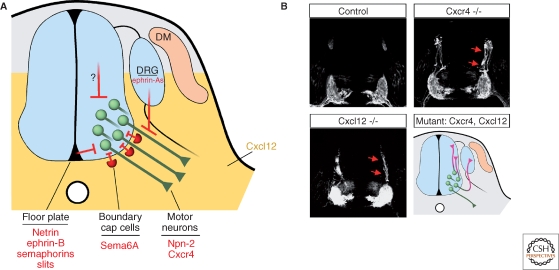Figure 2.
Motor axon outgrowth from the neural tube. (A) The initial trajectory of motor axon growth is defined by a combination of repulsive signals associated with the floor plate that orient axons away from the midline, and positive signals that attract motor axons toward their ventral exit points. Cxcl12 ligand (yellow) from the mesenchyme flanking the neural tube entices Cxrcr4-expressing motor axons to cross the neuroepithelium. It is unclear whether Cxcl12:Cxcr4 signaling has chemoattractive properties per se or influences the activity of other axon guidance systems. Sema6A expressed by boundary cap cells clustered at ventral exit points activates Nrp-2 receptors to confine motor neuron cell bodies within the neural tube. Repulsive signals from the dorsal neural tube and dorsal root ganglia (DRG) may further shape the proximal motor axon trajectory. (B) In Cxcl12 and Cxcr4 mutant embryos, motor axons marked by expression of the Hb9: :gfp transgene extend dorsally within the neuroepithelium (Reprinted, with permission, from Lieberam et al. 2005). Bottom right: schematic of the motor axon phenotypes of Cxcl12 and Cxcr4 knockout embryos. Note that the aberrant axonal trajectories observed in the mutants (purple) include invasion of the DRG.

